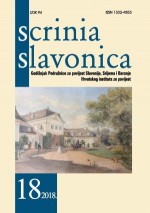Osječki trgovci na budimskoj tridesetnici 1716. i 1717. godine
Osijek Merchants at the Buda Customs Office in 1716 and 1717
Author(s): Milan VrbanusSubject(s): Economic history, International relations/trade, 18th Century
Published by: Hrvatski institut za povijest
Keywords: customs duty (tricesima); customs office; trade; merchants; Buda; Osijek; goods; family connections;
Summary/Abstract: The city of Osijek was awarded the Magistrate Instruction by the Caraffa Commission, which enabled the city to develop into the administrative and economic centre of Slavonia under the Chamber’s jurisdiction. With the implementation of this document, the citizens were exempted from commitments of inferior status and were free to engage in economic activities. At the end of the first decade of the 18th century the construction of the Osijek fortress started; the works continued throughout the second decade and ended at the beginning of the third decade of the century and thus the city also became the seat of the military command of the Slavonian Military Frontier. The exemption from commitments due to their inferior status enabled the citizens to focus on personal economic activities, i.e. the development of their own economy. Some of the citizens were engaged in trade activities. Hence, they decided to purchase or sell merchandise in nearby but also distant locations such as Buda or Bratislava. In 1716 the merchants from Osijek came with their merchandise 20 times to the customs clearance, i.e. customs control, and the following year 15 times. In 1716 the Buda customs office was visited by 14 and in the following year by 10 merchants. The merchants from Osijek delivered mainly textile products (textiles, thread, hemp fibre, Hungarian caps, bed linen, dresses) to the Buda customs and to a much smaller extent various merchandise such as spices (pepper, cloves and ginger), various types of fish, sugar, pigs, millstones, flour, glue, cheese, spelt groats, tin, frankincense, alum, paper, sulphur, brandy and boats. A large part of the goods consisted of purchases from Bratislava where the Osijek merchants paid the thirtieth (tax). The most outstanding Osijek merchants at the Buda customs were Joannes Peacsevics (Piacsovicsa), Gregorius Nicolantin (Nicolandy), Stephanus Stoigics (Stekics, Stegics) and to a lesser extent Jacobus Vergics (Veridics). The greatest part of the merchandise for customs clearance, i.e. customs control, was delivered by these four merchants.
Journal: Scrinia Slavonica
- Issue Year: 2018
- Issue No: 18
- Page Range: 99-128
- Page Count: 30
- Language: Croatian

